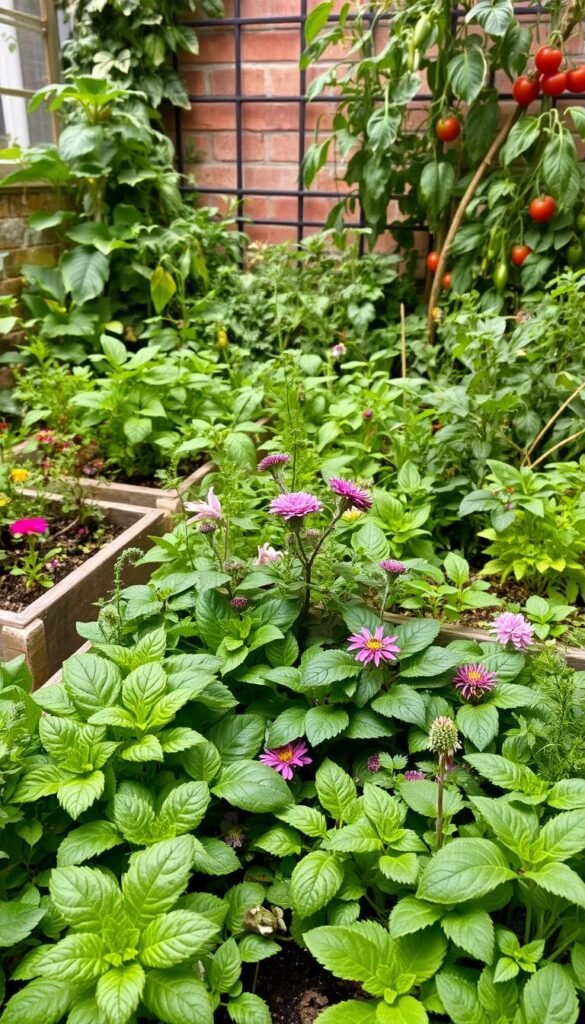Think your patio or balcony is too tiny for a thriving vegetable patch? Think again. With clever design and smart pairings, even a windowsill planter can overflow with fresh produce. The secret lies in strategic plant partnerships and vertical layouts that turn cramped areas into edible oases.
By grouping compatible species, you create natural support systems. Tall crops like pole beans shelter shade-loving lettuces, while fragrant herbs deter pests from nearby veggies. This approach reduces wasted room and lets you harvest multiple crops from the same soil footprint.
Successful micro-gardening starts with a thoughtful blueprint. Sketch your available area, noting sunlight patterns and drainage. Use vertical structures like trellises for vining plants, freeing ground space for root vegetables. Rotate quick-growing radishes between slower maturing peppers to maximize every inch.
Urban gardeners report surprising results from these methods. One Brooklyn resident grows juicy tomatoes alongside basil in stacked planters, while a Seattle apartment dweller harvests kale and spinach from hanging baskets. Your morning omelet ingredients could soon come from that overlooked corner by the fire escape.
Ready to transform your limited plot? The following sections break down practical techniques for creating your high-yield, space-smart garden. You’ll discover how to select perfect plant matches and design layouts that work harder than you ever imagined.
Understanding the Basics of Small-Space Gardening
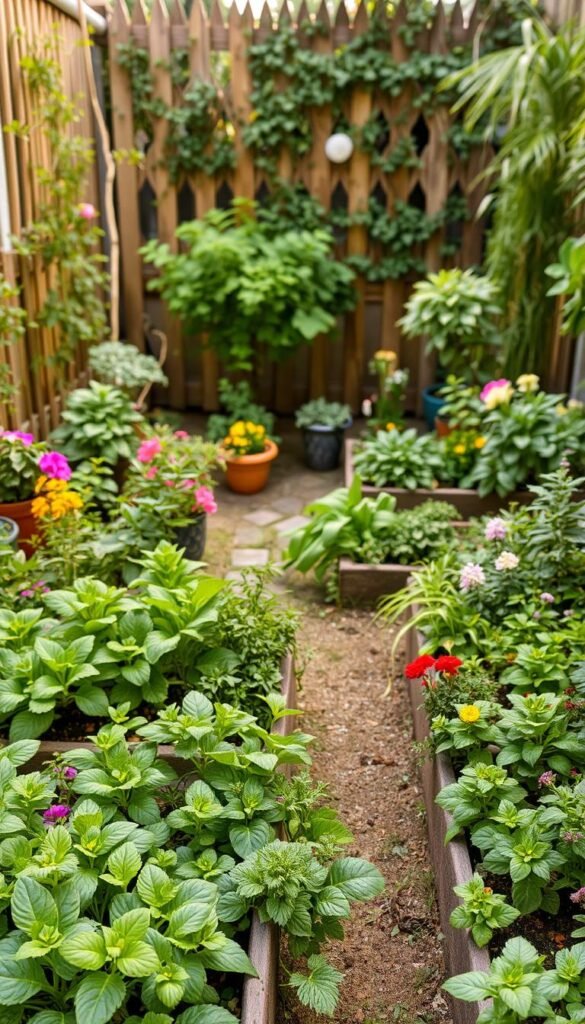
Starting your growing journey in limited areas requires smart planning. Before sowing seeds, take time to analyze your unique environment. This ensures your plants thrive without wasting precious room.
Assessing Your Available Garden Space
Grab a tape measure and notebook. Calculate every potential growing spot—window ledges, railings, and vertical surfaces count. Balconies often hold hidden potential: a 4’x6′ area can host 15+ plants if arranged well.
Check weight limits for hanging baskets and wall-mounted planters. A sturdy fence might support climbing peas, while lightweight trellises work for herbs. Don’t forget overhead space for trailing vines!
Evaluating Sunlight, Soil, and Drainage
Track sunlight patterns for 3 days using free apps like Sun Surveyor. Most veggies need 6+ hours of direct light. Leafy greens tolerate partial shade—perfect for north-facing spots.
| Tool | Purpose | DIY Alternative |
|---|---|---|
| Soil test kit | Check nutrient levels | Vinegar/baking soda pH test |
| Moisture meter | Prevent waterlogging | Finger soil test |
| Drainage holes | Avoid root rot | Coffee can punctures |
Improve dense soil by mixing in compost—it boosts drainage and prevents compaction. Elevate containers on bricks if puddles form after watering. Healthy roots mean happier plants!
Watch for early pest signs like chewed leaves. Planting garlic near roses or marigolds with tomatoes creates natural barriers. Address issues quickly to protect your mini ecosystem.
Companion Planting: Boosting Yield in Tight Garden Spaces
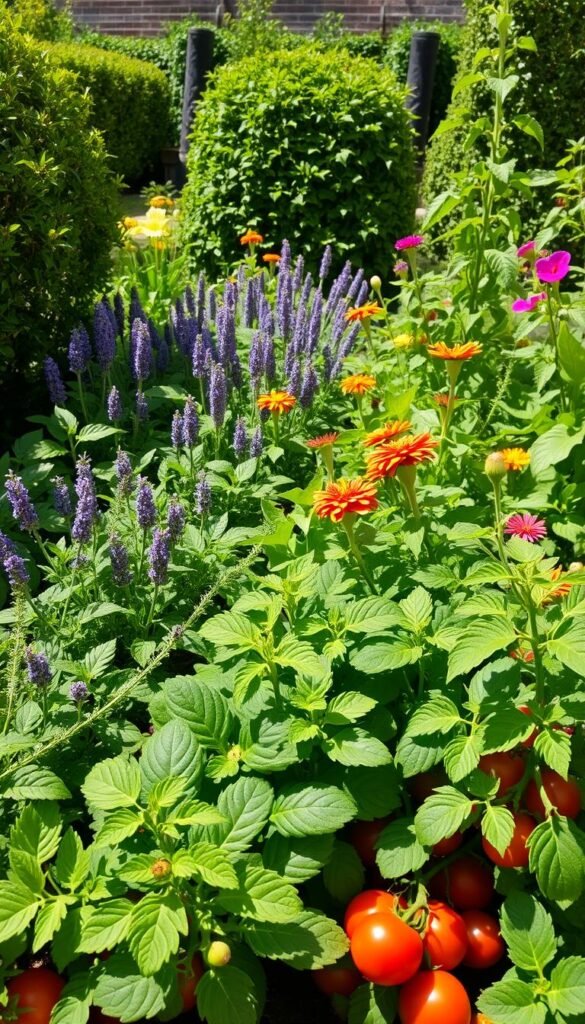
Strategic plant partnerships unlock hidden potential in compact growing zones. When you match species that help each other thrive, your limited area becomes a powerhouse of flavors and nutrients. These natural alliances reduce pest issues while making soil work smarter, not harder.
Why Neighborly Plants Outperform Solo Acts
Certain duos create mutual benefits underground and above. Basil releases compounds that protect tomatoes from insects while enhancing their flavor. Tall crops like corn give beans natural climbing poles, while squash leaves shade soil to retain moisture.
| Power Pair | Key Benefits | Space Saved |
|---|---|---|
| Tomato + Basil | Pest protection, flavor boost | 15% |
| Carrot + Onion | Root depth variation, pest confusion | 20% |
| Corn + Beans + Squash | Full vertical use, shared nutrients | 40% |
| Cucumber + Nasturtium | Trap cropping, pollinator attraction | 10% |
Top Teams for Tiny Plots
The Native American “three sisters” method shines in confined areas. Corn stalks support bean vines, while squash leaves suppress weeds. This trio uses vertical space efficiently – perfect for square foot layouts.
Try these space-savers:
Radishes with spinach: Quick harvest radishes make room for slower greens
Marigolds with peppers: Flowers deter nematodes while peppers grow taller
Chives with roses: Natural aphid control adds edible beauty
Test different combinations in your unique microclimate. Track which pairs produce best results – your balcony might become the envy of the neighborhood!
Maximizing Yield with Vertical Gardening Techniques
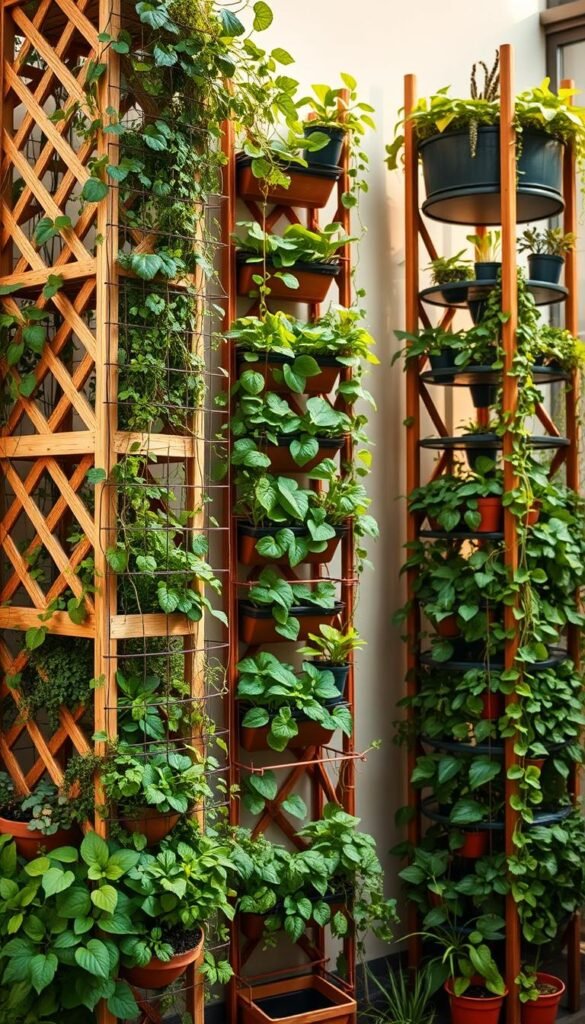
Reach new heights with vertical gardening—your secret weapon for transforming blank walls and narrow areas into lush, edible displays. This method turns underused vertical surfaces into productive zones, letting you grow more without expanding your footprint. You’ll gain extra room for herbs, flowers, and vegetables while keeping pathways clear for easy care.
Installing Trellises and Support Systems
Start by securing sturdy supports to walls or railings. Use galvanized screws and concrete anchors for brick or stucco surfaces—they withstand weather better than regular hardware. For wooden fences, attach wire grids with heavy-duty staples. Always check weight limits before adding hanging planters.
| Structure Type | Best For | Installation Time |
|---|---|---|
| Wall-mounted grids | Cucumbers, peas | 45 minutes |
| Freestanding arches | Pole beans, grapes | 2 hours |
| Hanging pockets | Strawberries, herbs | 20 minutes |
Choosing Climbing Plant Varieties for High Productivity
Focus on vigorous growers that thrive upward. Indeterminate tomatoes produce fruit all season when trained on strings. Armenian cucumbers yield 10-15 fruits per vine. Try these space-saving stars:
- Scarlet Runner Beans: 6-foot vines with edible flowers
- Sugar Snap Peas: Quick harvest in 60 days
- Malabar Spinach: Heat-tolerant leafy green
Pair vertical systems with ground-level crops like carrots or radishes. You’ll double your harvest while making watering and pruning easier. Your plants will thank you with fewer pest issues and sun exposure!
Strategies for Container and Square Foot Gardening
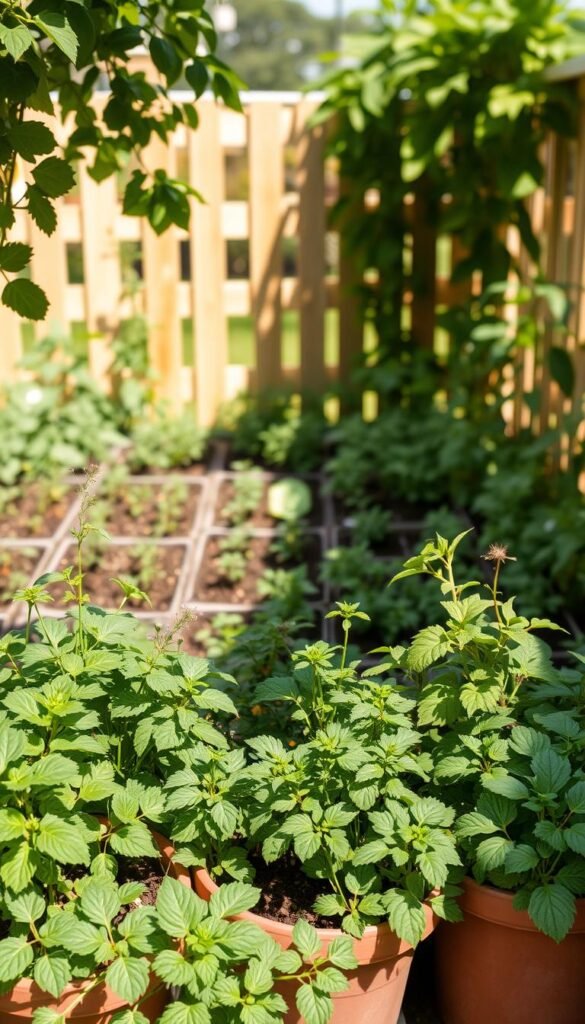
Urban growers are flipping the script on limited space with clever container solutions and grid-based designs. These approaches let you cultivate fresh herbs and veggies even on fire escapes or patios. The key lies in matching your setup to plant needs while keeping maintenance simple.
Smart Container Choices and Layout Design
Pick pots based on root depth and growth habits. Tomatoes thrive in 5-gallon buckets with drilled drainage holes, while shallow lettuce works in 6-inch window boxes. Group moisture-loving plants like mint in self-watering planters to simplify care.
| Container Size | Best For | Drainage Tips |
|---|---|---|
| 12″ deep | Peppers, eggplant | 1 hole per 6″ diameter |
| 18″ wide | Zucchini, cucumbers | Elevate on bricks |
| 8″ shallow | Radishes, microgreens | Layer gravel base |
The square foot gardening method turns small plots into high-output zones. Divide raised beds into 1×1 grids—plant 9 spinach per square or 1 broccoli centerpiece. This system prevents overcrowding and makes rotation easy.
Mix potting soil with perlite for better drainage. Add slow-release fertilizer to nourish plants all season. Remember: even a 2’x4′ setup can yield salad greens daily if you stagger plantings!
Intensive Planting: Enhancing Productivity in Tight Spaces
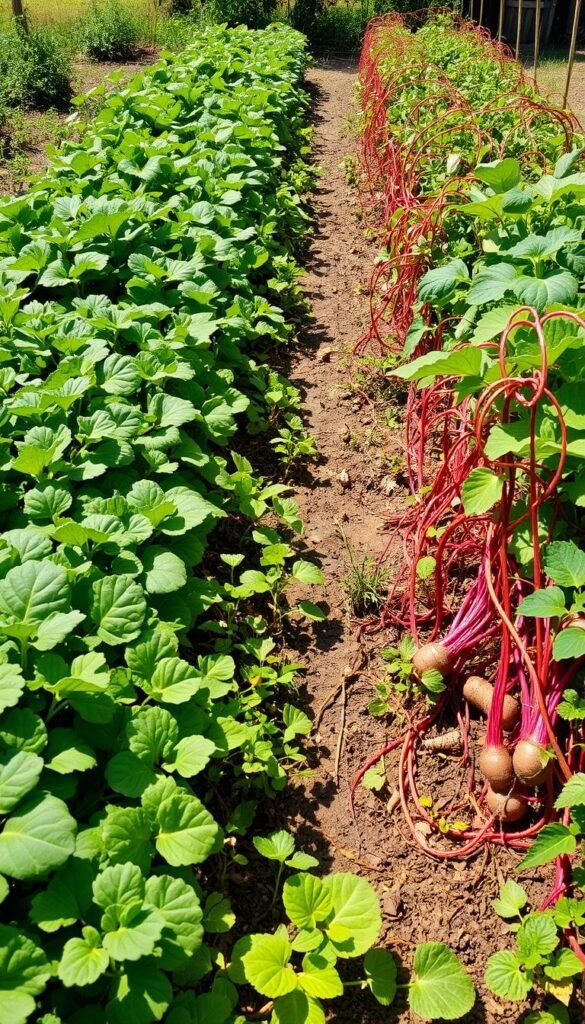
What if your limited growing area could produce like a full-sized farm? Intensive methods turn every square inch into a powerhouse of continuous harvests. By layering plantings and timing crops strategically, you’ll squeeze more value from your soil while keeping it healthy.
Implementing Succession and Interplanting Methods
Succession planting keeps your soil working year-round. After pulling up quick-growing radishes, immediately sow spinach or arugula in the same spot. This back-to-back approach works great for cool-weather crops that mature fast.
Try these winning combos:
- Lettuce seedlings around young tomato plants
- Bush beans between rows of slow-growing cabbage
- Carrot seeds alongside taller kale starters
Interplanting pairs fast and slow growers perfectly. While your peppers develop over months, harvest three rounds of baby greens at their base. This layered approach prevents bare patches that lead to soil compaction and weed growth.
Mark planting dates on a calendar divided into 1-foot grids. When one crop finishes, have seedlings ready to plug in. Your small spaces will become nonstop producers—imagine fresh salads in spring, beans in summer, and kale through frost!
Smart Irrigation and Nutrient Management
Your plants’ thirst and hunger need smart solutions in cozy growing areas. Proper watering and feeding keep crops thriving without wasting resources. Let’s explore systems that deliver just what your greens need—no more, no less.
Setting Up Efficient Drip Irrigation Systems
Drip systems target roots directly, cutting water use by 50% compared to sprinklers. Start with microtubing connected to a rain barrel or outdoor faucet. Add emitters every 12 inches for veggies like tomatoes, spacing them closer for thirsty greens.
| Emitter Type | Flow Rate (GPH) | Best Use |
|---|---|---|
| Drip Tape | 0.5 | Row crops |
| Adjustable Emitter | 0-10 | Containers |
| Soaker Hose | 1 per foot | Raised beds |
Moisture sensors prevent overwatering—install them 3 inches deep near plant bases. Pair with timers to automate watering during cooler mornings. You’ll save time and keep soil from drying out.
Custom Fertilizer Schedules and Soil Health Tips
Test soil every spring using kits from garden centers. Most veggies thrive at pH 6.0-7.0. Amend acidic soil with lime, or add sulfur if it’s too alkaline. Mix compost into beds monthly for slow-release nutrients.
| Plant Type | Nutrient Needs | Feeding Schedule |
|---|---|---|
| Tomatoes/Peppers | High phosphorus | Every 2 weeks |
| Leafy Greens | Nitrogen boost | Monthly |
| Herbs | Low fertilizer | Once at planting |
For square foot layouts, use liquid seaweed every 3 weeks. It prevents compaction by feeding microbes that loosen soil. Your plants will grow stronger roots and resist pests naturally!
Maximizing Space with Interplanting Techniques
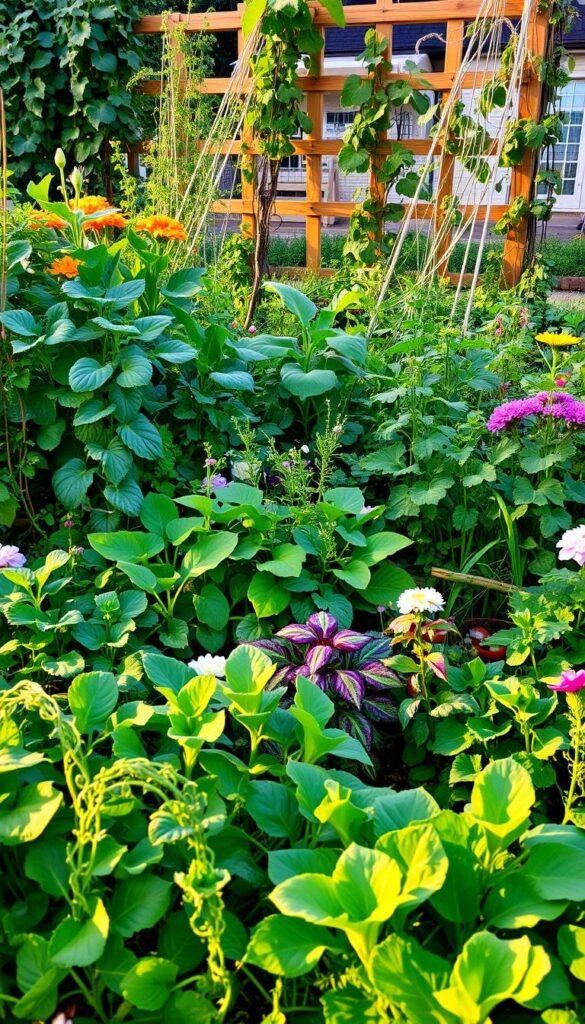
Ever wish your limited soil could produce multiple harvests? Interplanting lets you grow two or more crops in the same spot at different times. This smart approach fills every square foot with continuous growth while protecting your ground from weeds.
Double-Duty Planting Strategies
Pair quick growers like radishes (ready in 25 days) with slow-maturing veggies like cabbage. The early crop shields soil while the later one develops. After pulling radishes, the cabbage gets full space to expand. This keeps your ground productive all season.
| Fast Crop | Slow Crop | Benefits | Harvest Window |
|---|---|---|---|
| Radishes | Carrots | Break soil crust | 25 days + 70 days |
| Lettuce | Brussels Sprouts | Shade roots | 30 days + 100 days |
| Spinach | Peppers | Prevent erosion | 40 days + 90 days |
Leafy greens planted around tomato seedlings act as living mulch. They retain moisture until the tomatoes need more room. Try these techniques in small spaces:
- Sow arugula between broccoli rows
- Nestle basil under pole bean supports
- Plant scallions beside slow-growing melons
You’ll use your space smarter while building healthier soil. Fewer bare spots mean fewer weeds and better water retention. Start with one combo this season – your salad bowl will thank you!
Planning Your Garden Layout for Continuous Growth
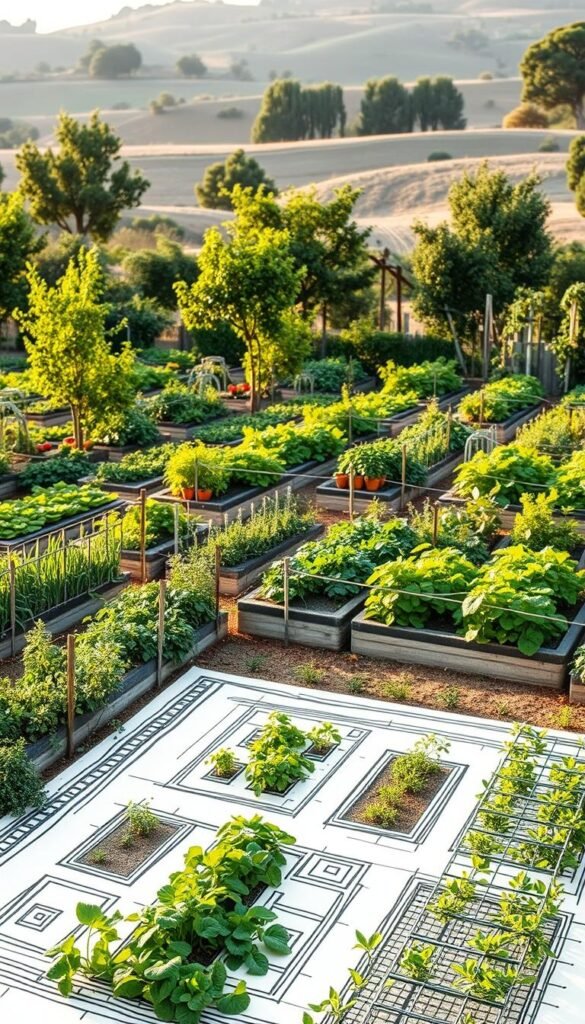
Your small space can produce continuously with strategic arrangement and access. Smart layouts balance plant needs with your ability to care for them, turning cramped quarters into efficient growing zones. Thoughtful design prevents overcrowding while ensuring every inch works overtime.
Designing Paths and Raised Beds for Accessibility
Keep paths narrow (18-24 inches) but comfortable for kneeling and harvesting. Curved walkways add visual interest while guiding you through the garden area. Raised beds elevate plants for better drainage and reduce back strain—perfect for root vegetables and heat-loving crops.
Divide your plot using the square foot method for maximum efficiency. A 4×4 bed might hold:
- 16 carrot clusters in one square
- 4 broccoli plants center stage
- 8 bush beans along the edges
| Layout Type | Best For | Path Width |
|---|---|---|
| Raised Beds | Small root crops, herbs | 24″ |
| In-Ground Rows | Corn, peas | 18″ |
| Vertical Towers | Strawberries, flowers | 12″ |
Rotate crops using a seasonal calendar. Follow nitrogen-hungry spinach with soil-restoring beans. This prevents pests and keeps nutrients balanced. Tools like the Old Farmer’s Almanac Planner simplify scheduling for year-round harvests.
Remember: good planning means less weeding and watering. Your future self will thank you when harvesting ripe tomatoes without stepping on basil!
Harvesting and Enjoying Your Homegrown Bounty
Your patience pays off when plump tomatoes blush red and peppers reach their full size. Pick leafy greens in the morning when crisp—they’ll stay fresh longer. For juicy results, twist peas off vines gently and snip herbs just before flowering.
Timing matters. Harvest zucchini at 6-8 inches for tender skin. Let carrots loosen in damp soil before pulling. This protects roots and keeps your production steady. Always leave some basil leaves to keep plants generating new growth.
Celebrate your haul with vibrant salads or freeze chopped herbs in olive oil. Dry extra chili peppers on sunny windowsills. These simple techniques let you savor summer flavors all year.
Reflect on what thrived this growing season. Note which pairings boosted yields and where water adjustments helped. Next spring, rotate crops to new spots—your soil will reward you with even tastier fruits.
Every bite of homegrown food proves smart planning works. You’ve transformed limited space into a living pantry. Now share those sun-warmed cherry tomatoes with neighbors—they’ll taste victory in every sweet burst!

